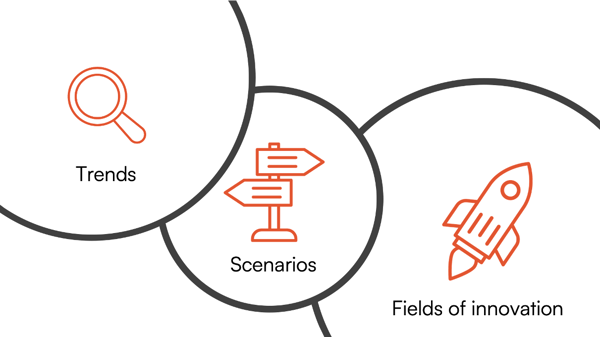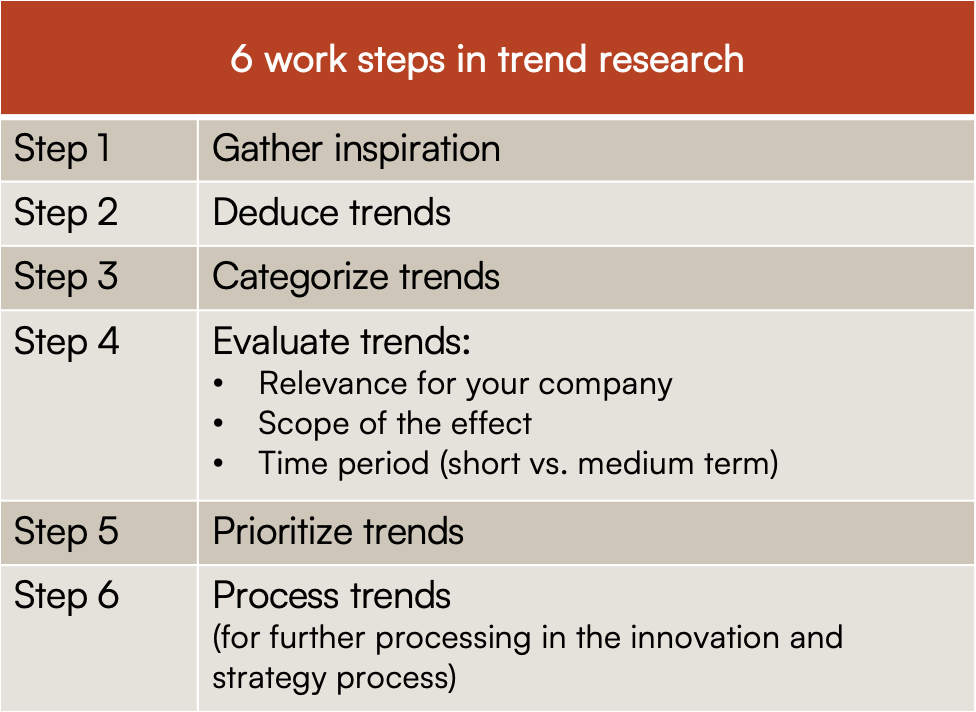Trend research: how to identify relevant trends
Trend research is an important part of business strategy and can help companies understand their customers' needs and develop innovative solutions. But how can you identify relevant trends?

There are different methods for having your finger on the pulse, whether that be by observing changes in society, analyzing data, or following developments in technology. However, successful trend research also requires creativity and keeping an eye on unexpected changes. This is the only way companies can pick up on tomorrow's trends early on and adapt to them.
Defining the word 'trend'
A trend is an assumed development in the future that causes and changes something enduringly over the long term. Current developments move in a different direction or intensify even more.
Trends in one industry usually have far-reaching effects. Nutrition trends, for example, induce changes in the retail, hospitality, tourism, leisure, and agriculture sectors.
Those who miss out on the trends risk losing out and being overtaken by the competition. That is why companies should not neglect trend research and should actively seek out new developments.
Identify trends: identifying opportunities and risks
Change brings risks and opportunities. A change can mean a risk for a company if the market is restructured and there is no longer a demand for its own product. Yet change also brings many opportunities and possibilities for new innovations.
If a company takes a proactive role, it can help shape the future, launch products that stand the test of time, and not be surprised by destructive changes.
This is the task of trend research and innovation management. Potential for the future is to be identified today, and solutions are developed that will be needed tomorrow. The future is something that is shaped, rather than the future doing the shaping. However, this requires good, solid information on possible trends, future developments and their effects.
What is trend research?
Trend research is a method of predicting future developments and changes in various fields. To this end, data from various sources such as surveys, statistics, or expert interviews are used. The results of trend research can help companies to adapt their products or services to the needs of their customers and to react to new trends in good time.
Trend management
Trends are ever-present and influence our lives in many ways. However, they are not just short-lived hype, but can also have long-term effects. Therefore, it is essential in innovation management to establish trend management. Effective trend management enables companies to adapt to new challenges at an early stage and thus position themselves for the long term. It is therefore an important component for a successful innovation strategy and should not be neglected.
Since trends are highly multidimensional, the art of trend management lies in "disentangling the threads". Many trends that you don't see in your own industry at first glance may nevertheless have relevance for your own business due to chain and interaction effects.
- Identifying trends – "What trends are there or will there be in the future? And which of these are relevant to us?"
- Analysis of the effects and possible projections and scenarios – "In which directions can a trend develop? What impacts can a trend generally have?"
- Analysis of the implications on one's own industry or company and deducing of search areas and innovation fields – "What does the trend mean for our company?"

How does trend management work?
Trend management is an important component of innovation management. It is about recognizing trends at an early stage and making them useful for one's own organization. There are two approaches to this:
- External trend scouts or experts monitor trends for the organization. This knowledge is then processed internally and combined with the company's own ideas.
- Trend management is managed internally. Information is collected and processed from various sources; e.g. at trade fairs, new technologies, changes in customer behavior, analysis of social media channels.
Trend research systematically searches for relevant developments on the market
The process of trend research is not high science. It involves many and intensive analyses of:
- Megatrends: There are many publications on megatrends. Megatrends are long-term developments over several decades that have a formative effect on all areas of society and the economy globally.
- Environment: Changes in the corporate environment also have an indirect and direct effect on the company's own organization. Analysis of the environment includes customers, users, customers of customers, suppliers, administration, adjacent companies and industries (e.g. upstream and downstream), etc.
Once you have identified the relevant trends, answer the following questions:
- What impact do the megatrends have on our company, our business, and our industry?
- What impact do the megatrends have on our environment (e.g. customers, laws)?
- What major changes and developments will there be?
- What do these mean for our company, our business, and our industry?
- What trends are there in our industry?
- Which global trends (macro trends) are still relevant for my company, and most importantly: why?
With a method toward the relevant trends
The basis of trend identification is asking the right questions as shown above. Answering them is nothing less than a creative process that requires a great deal of knowledge, experience, and analytical and creative thinking.
Two methodological approaches to trend research:
- Primary research: Use interviews with customers, lead users, experts (science and industry), users, employees and suppliers to this end. Workshops with experts and stakeholders or a Delphi study are also suitable.
- Secondary research: Access information that is available. There are a variety of trend reports for a wide range of industries that can definitely be used as a source and basis for trend identification.
Tip: As part of primary research, first determining the available trends by means of secondary research is also recommended. In addition, research using AI tools, such as ChatGPT, helps to get an initial feel for the trend landscape in an industry.

Broad benefits of trend research
It is never possible to predict exactly which trends or developments will result in drastic changes for a company. However, trend management, as part of strategic innovation management, makes a significant contribution to turning visions into reality.
Of course, the results of trend research are not the end of the story. To ensure that your company is fit for the future, use the findings of trend research as follows:
- Deduce search areas
- Develop a roadmap (more about roadmapping)
Even beyond the innovation strategy, the clarity gained about possible future scenarios helps you, for example, with the development of a corporate strategy.
Every corporate decision also always has to do with the future. It is therefore important to disseminate the results of trend research widely within the company and to initiate a discussion about them. If employees actively engage with the future, a creative process is set in motion that fills the idea funnel with better ideas.
Filling the idea funnel is only one aspect of achieving continuous innovation. Those responsible for innovation must create the framework for their organization to become holistically innovative. Find out how in the following article: House of Innovation, this is how CEOs make their company innovative.











